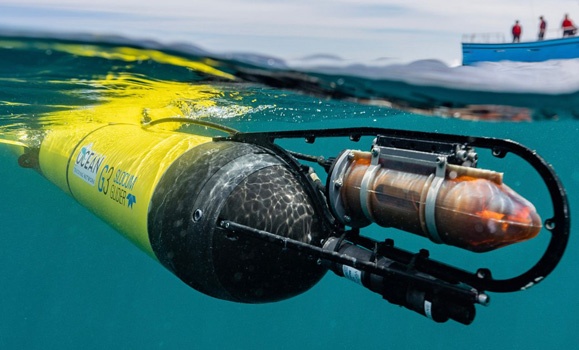Canada is growing itsâ¯suite of innovative monitoring technologies to protect the North Atlantic right whale.â¯
Ìı
The Ocean Tracking Networkâ¯(OTN)â¯and AV¾ãÀÖ²¿, in partnership with the University of New Brunswickâ¯(UNB)â¯and Transport Canada,â¯have established aâ¯$3.6-millionâ¯project toâ¯conduct monitoring of North Atlantic right whales in the Gulf of St. Lawrence using ocean-goingâ¯marine autonomous vehicles called underwater gliders.â¯â¯
Ìı
The project hasâ¯allowedâ¯OTNâ¯toâ¯purchaseâ¯a newâ¯state-of-theâ¯artâ¯G3â¯Slocumâ¯underwater glider. This robot will be added to the fleet of gliders operated and maintained by AV¾ãÀÖ²¿âs Coastal Environmental Observation Technology and Research group (CEOTR).â¯â¯
Ìı
The glider willâ¯be equipped withâ¯aâ¯newâ¯hydrophone developedâ¯atâ¯theâ¯Woods Hole Oceanographic Institution (WHOI). Itâ¯identifiesâ¯the callsâ¯of North Atlantic right whales as they navigate Canadian waters andâ¯providesâ¯nearâ¯real-time whale detectionsâ¯toâ¯authoritiesâ¯to help avoid collisions with vessels in busy shipping corridors.â¯Hydrophone-equippedâ¯underwater gliders also detect and report theâ¯callsâ¯ofâ¯other large whales, including blue, fin, sei and humpback.â¯
Ìı
âGlider data isâ¯helping us know where whalesâ¯areâ¯in time toâ¯help inform decisions that could reduce collisions with vessels â one of the main causes of death for these whales,ââ¯says Fred Whoriskey, executive director with OTN.
Extending and enhancing surveillance
Transport Canada is providing up to $2.8 million towards this five-year project, withâ¯an additional $800,000 in-kind contribution to supportâ¯gliderâ¯operationsâ¯and data processing provided by OTN andâ¯UNB.â¯
Ìı
Over the past five years, the federal government hasâ¯deployedâ¯a comprehensive suite of tools toâ¯monitorâ¯and protect the North Atlantic right whale, includingâ¯aircraft surveillance and ship-basedâ¯visual surveys in the gulf, and the glider programâ¯operatedâ¯by OTN and CEOTR to name a few.â¯This new project will extend and enhance existing right whale monitoring work forâ¯at leastâ¯the nextâ¯fiveâ¯years.â¯
Ìı
âThe Government of Canada remains committed to protecting the endangered North Atlantic right whale and continues to take action to support the speciesâ recovery. This investment will improve our ability to monitor for these whales in the Gulf of St. Lawrence. The data collected from these gliders will provide information for additional vessel traffic management measures that could reduce the risk of collisions between vessels and whales,â says the Honourable Omar Alghabra, minister of transport.
Ìı
Kim Davies, aâ¯right whale expert atâ¯UNB, is the scientific lead for the project.â¯She has led the design of glider survey paths for theâ¯2021â¯season, andâ¯allâ¯acoustic recordingsâ¯from the glidersâ¯indicatingâ¯the presenceâ¯of whales are confirmed by analysts in her lab.â¯â¯
Managing and mitigating risk
The recent shift of the North Atlantic right whale from its more traditional seasonal feeding grounds in the Bay of Fundy and theâ¯Rosewayâ¯Basin to the Gulf of St. Lawrence has increased the risk of collisions with vessels and entanglement in fishing gear for this endangered species.â¯
Ìı
In late 2020, Canada ordered two temporary fishery closures in theâ¯Rosewayâ¯Basin after multiple right whale detections in the area.â¯
Ìı
âThe information gathered will be used to help inform decisions to manage human activitiesâ¯andâ¯mitigateâ¯risks to whales.â¯While the whales do not call all the time, calls are not affected by darkness or rough surface conditions, making acoustic monitoring aâ¯valuableâ¯toolâ¯in efforts to protect the right whale,â says Davies.â¯

